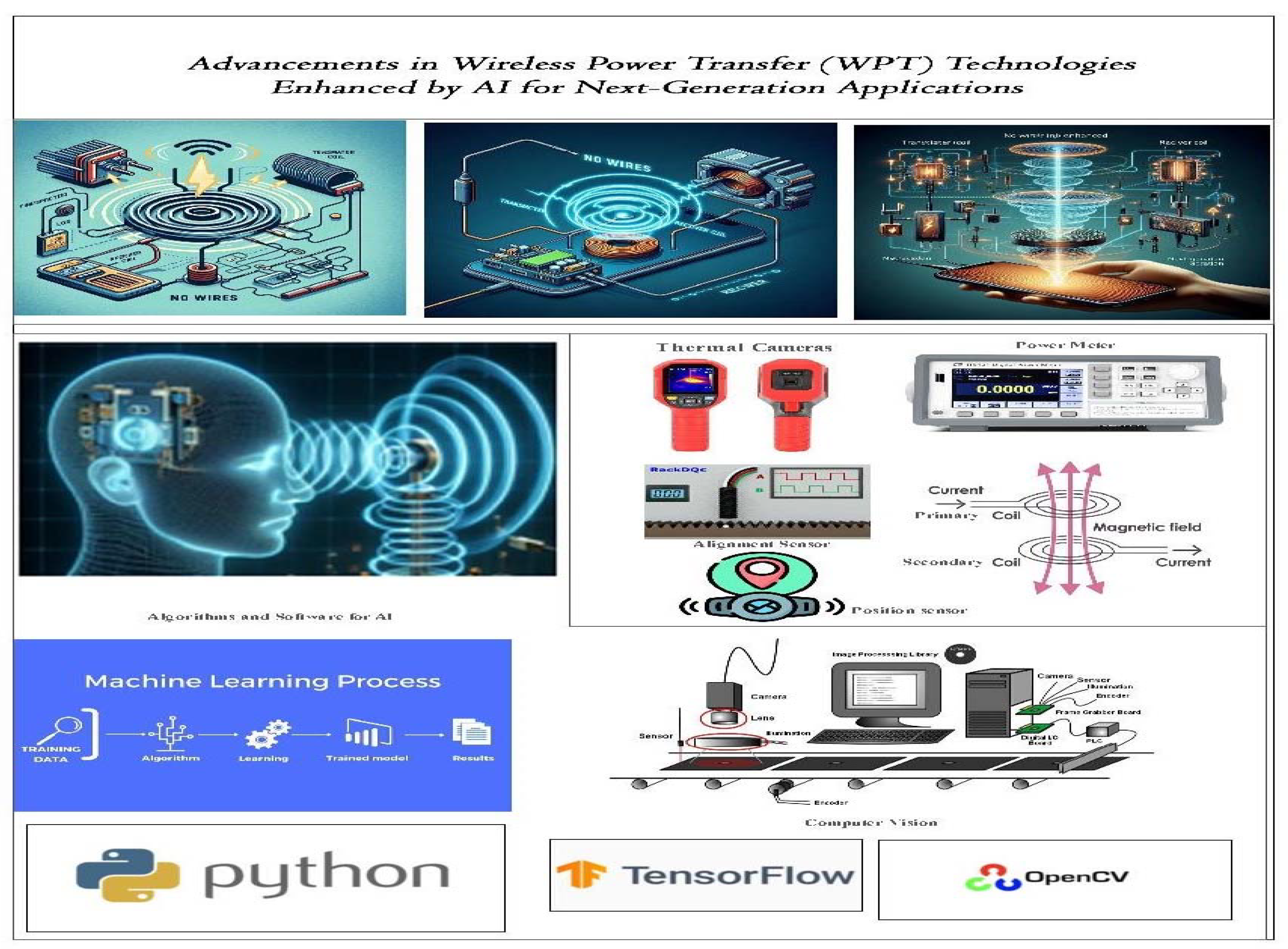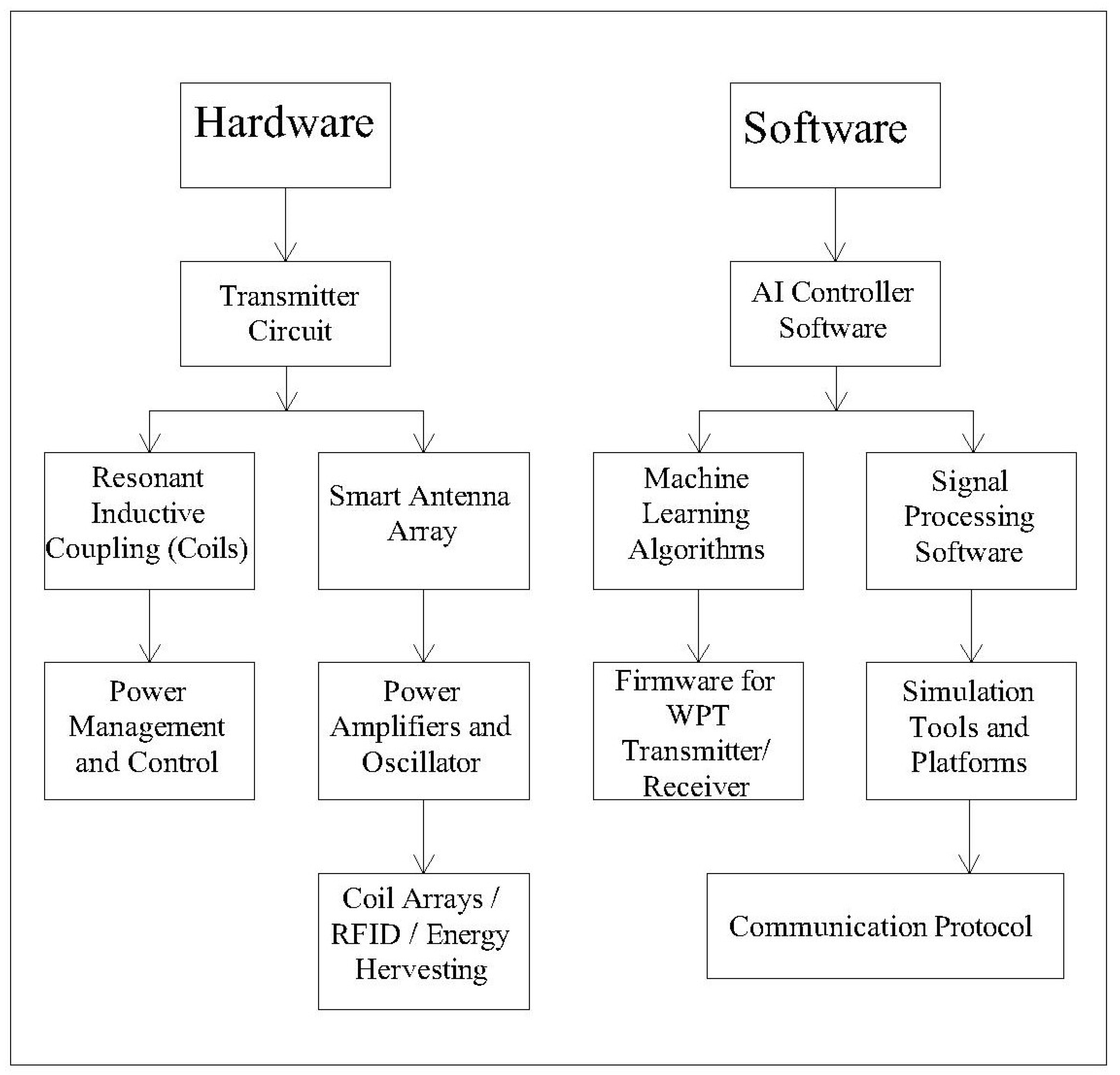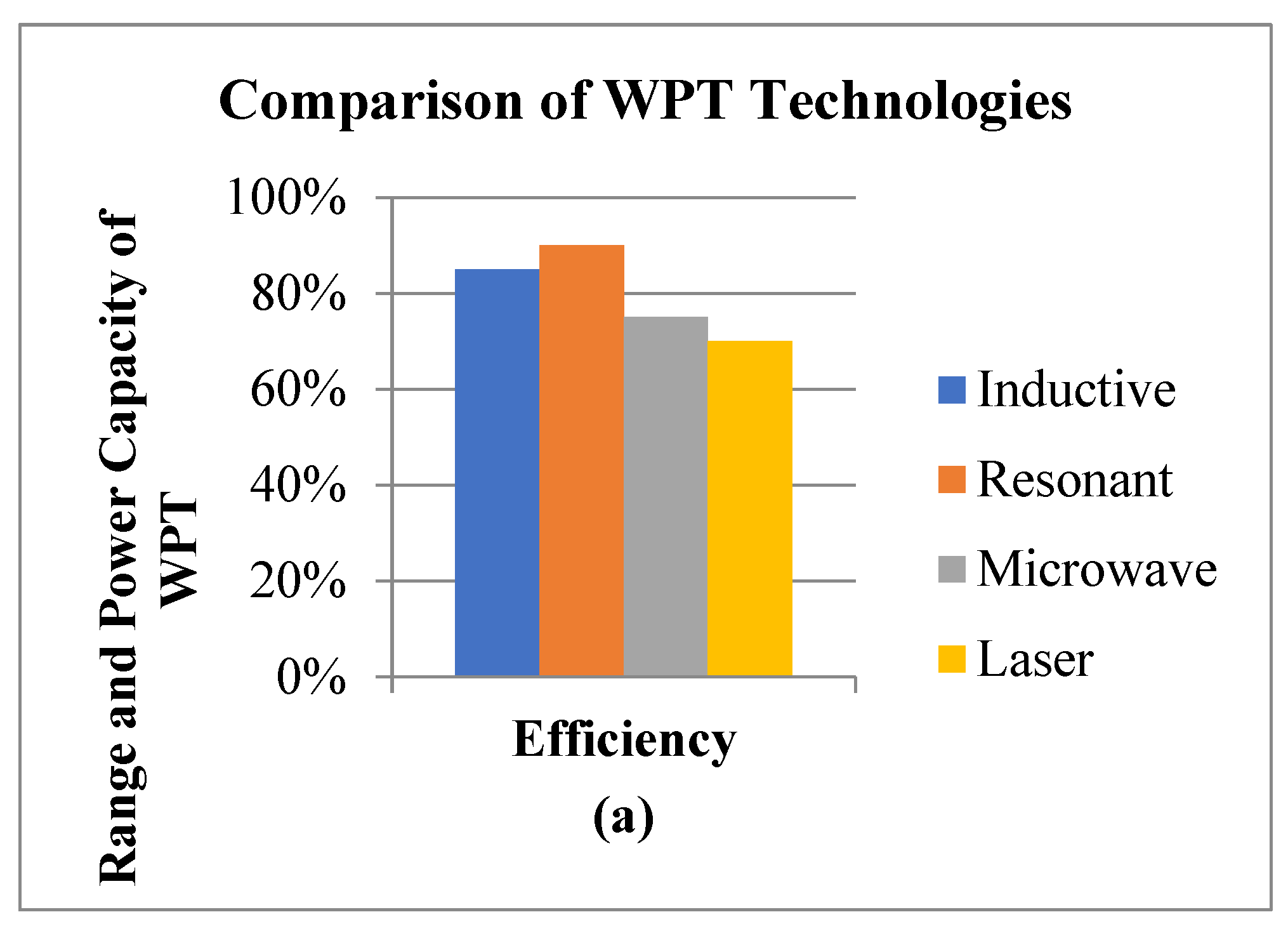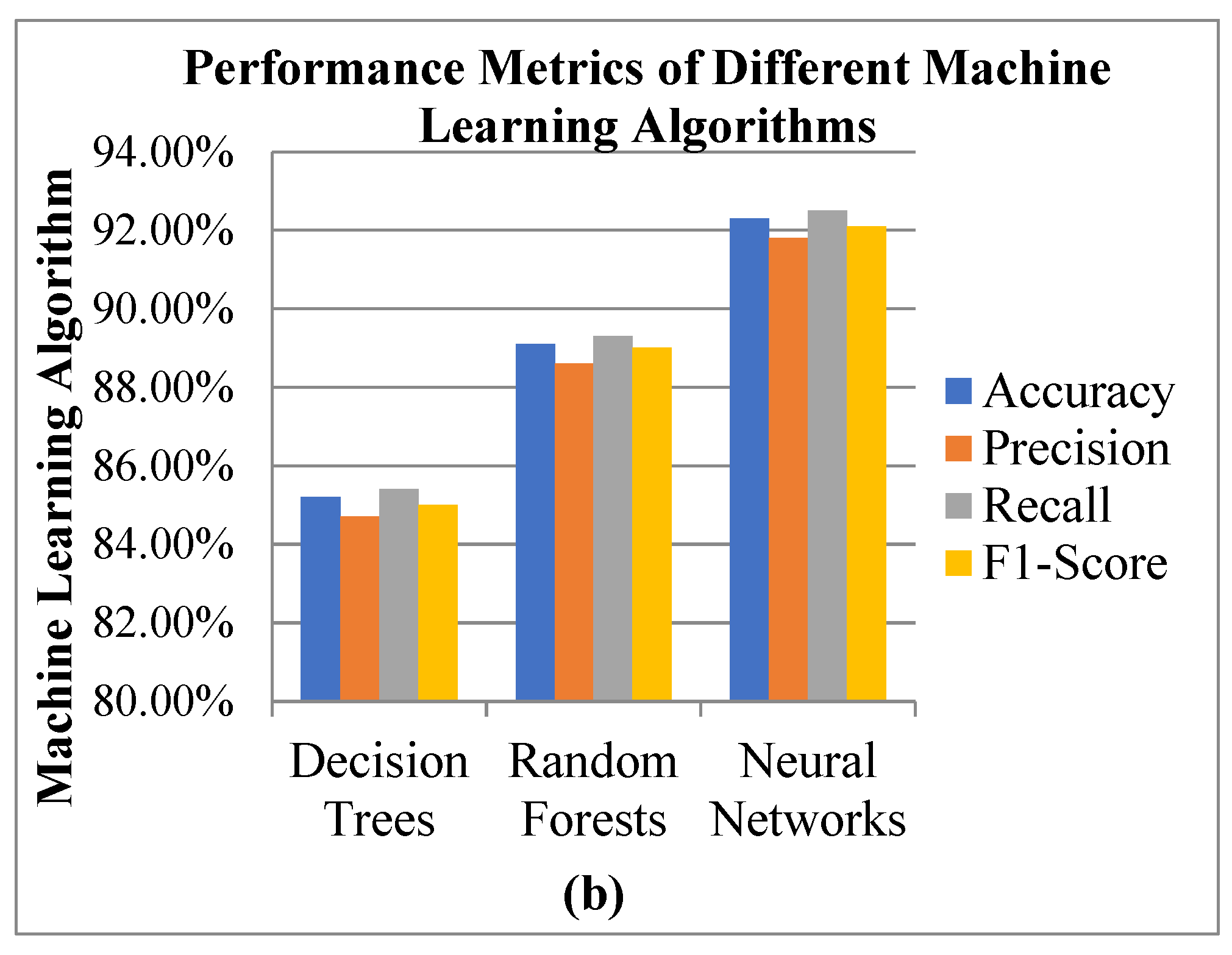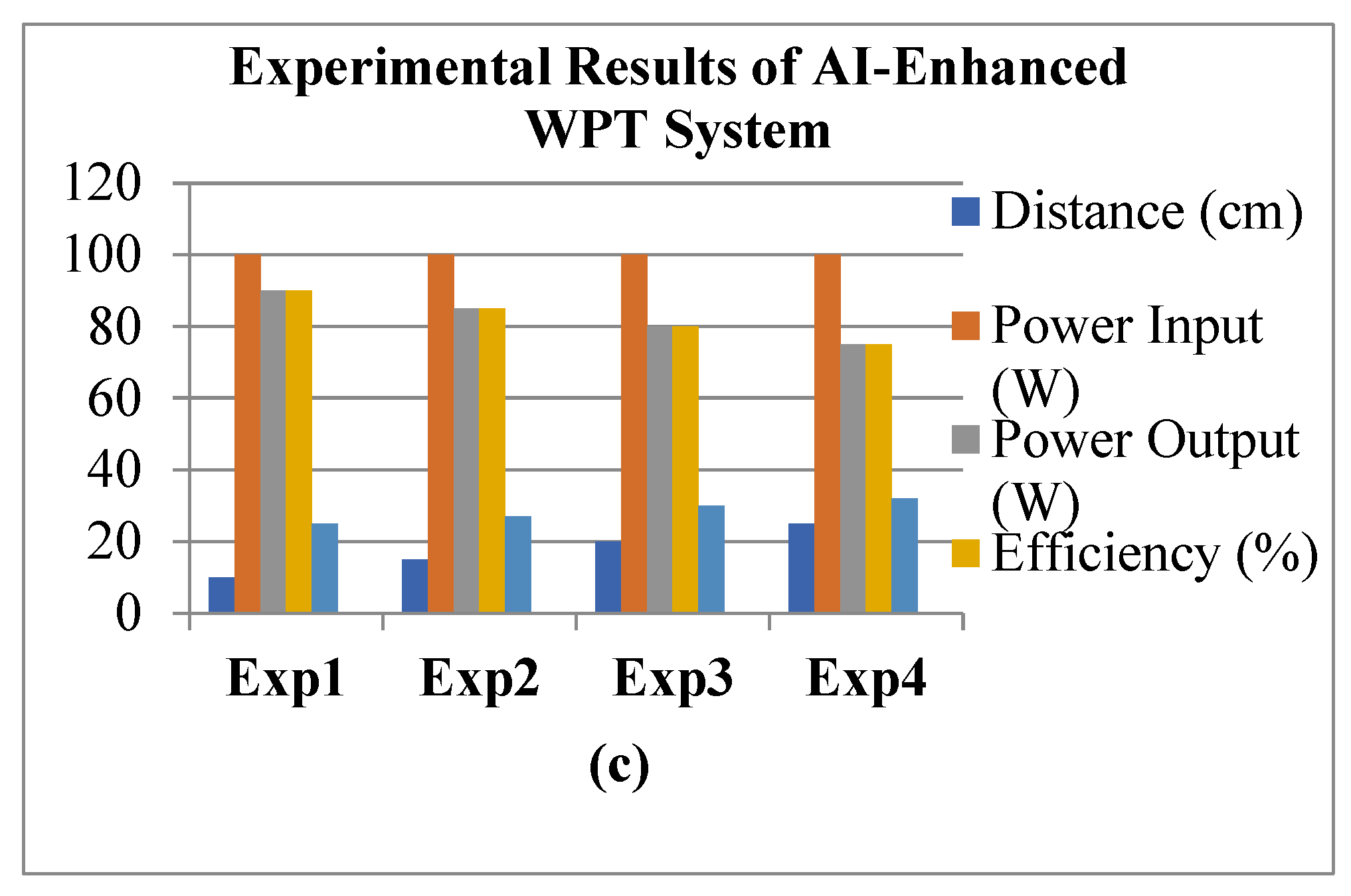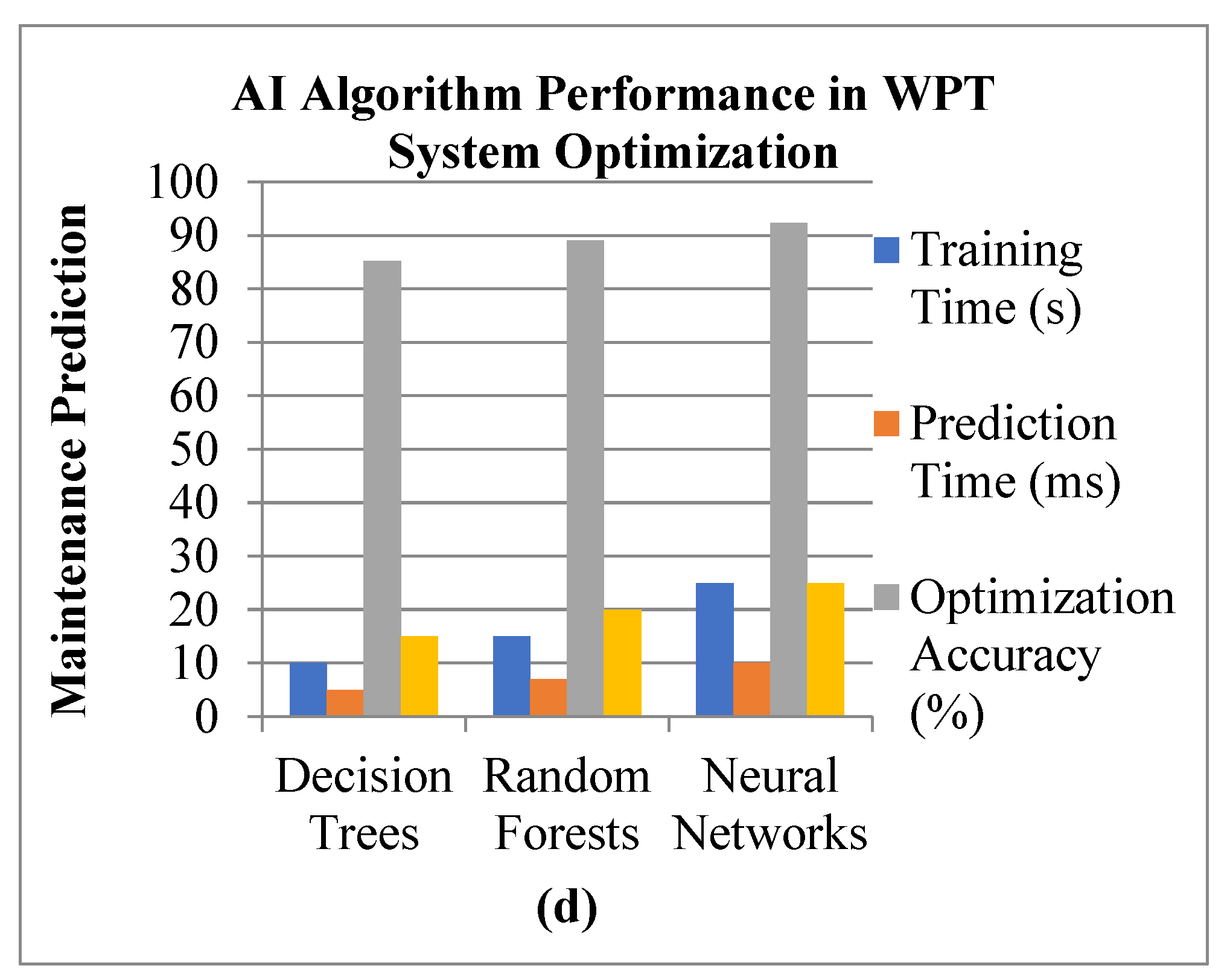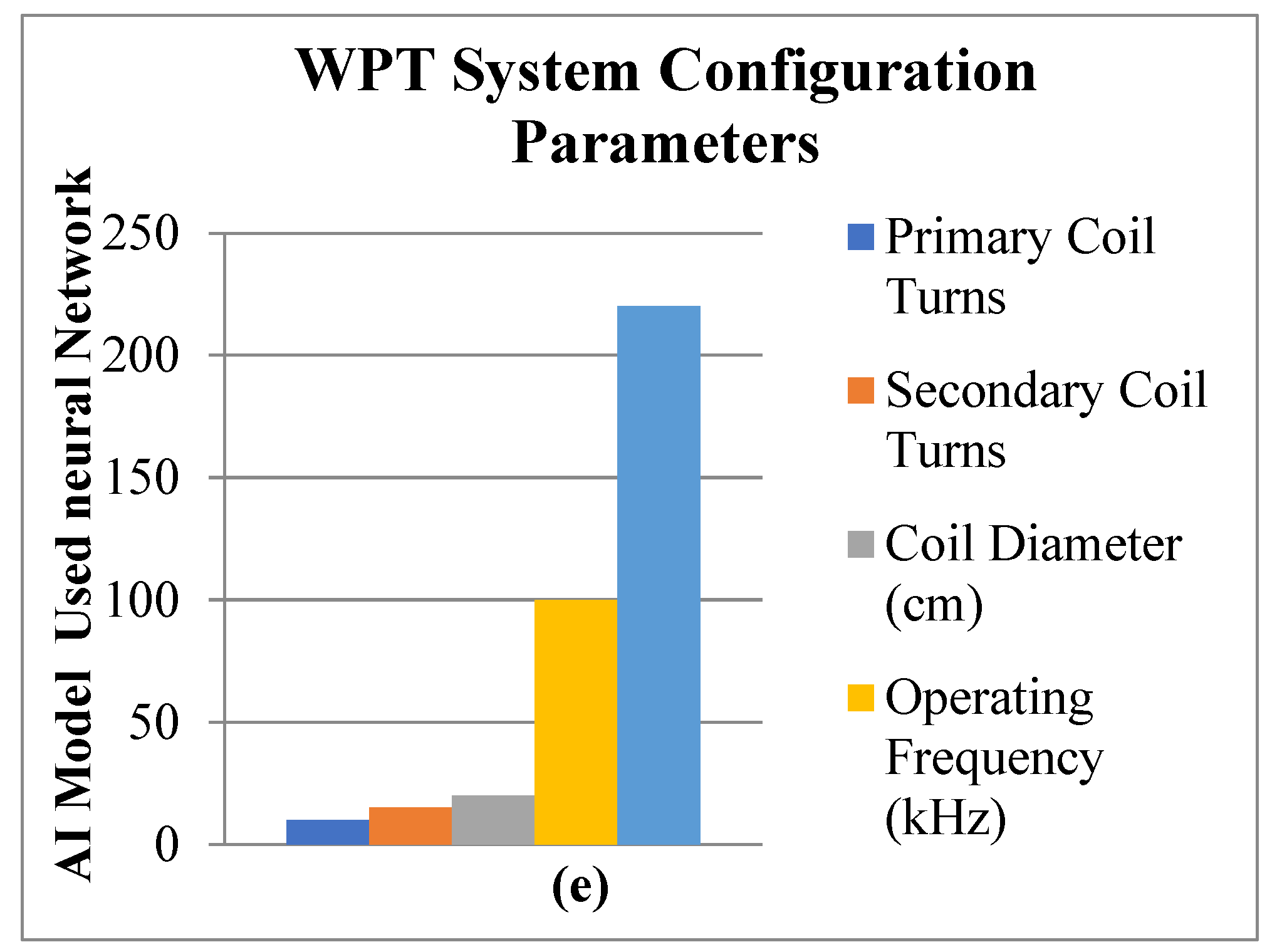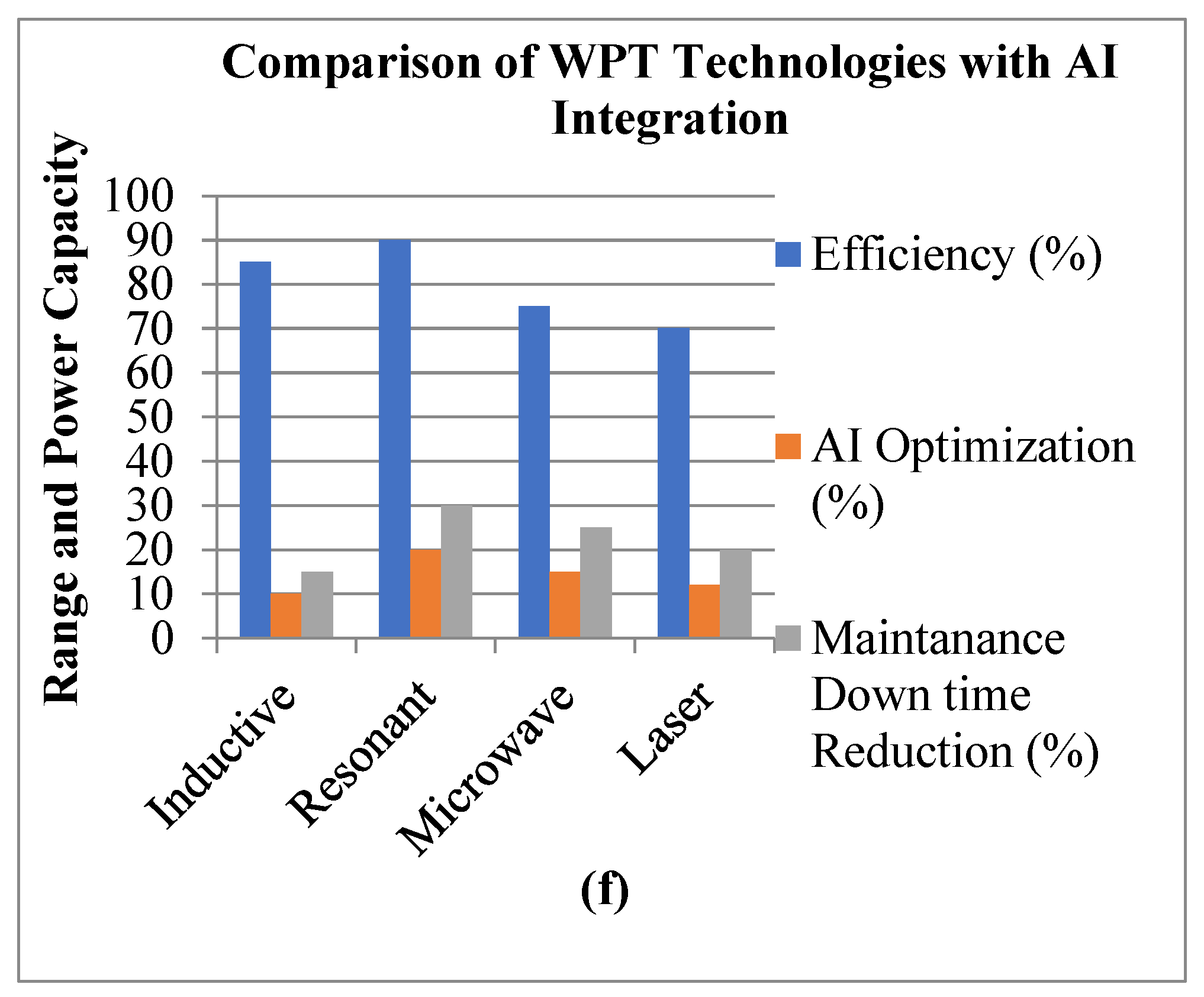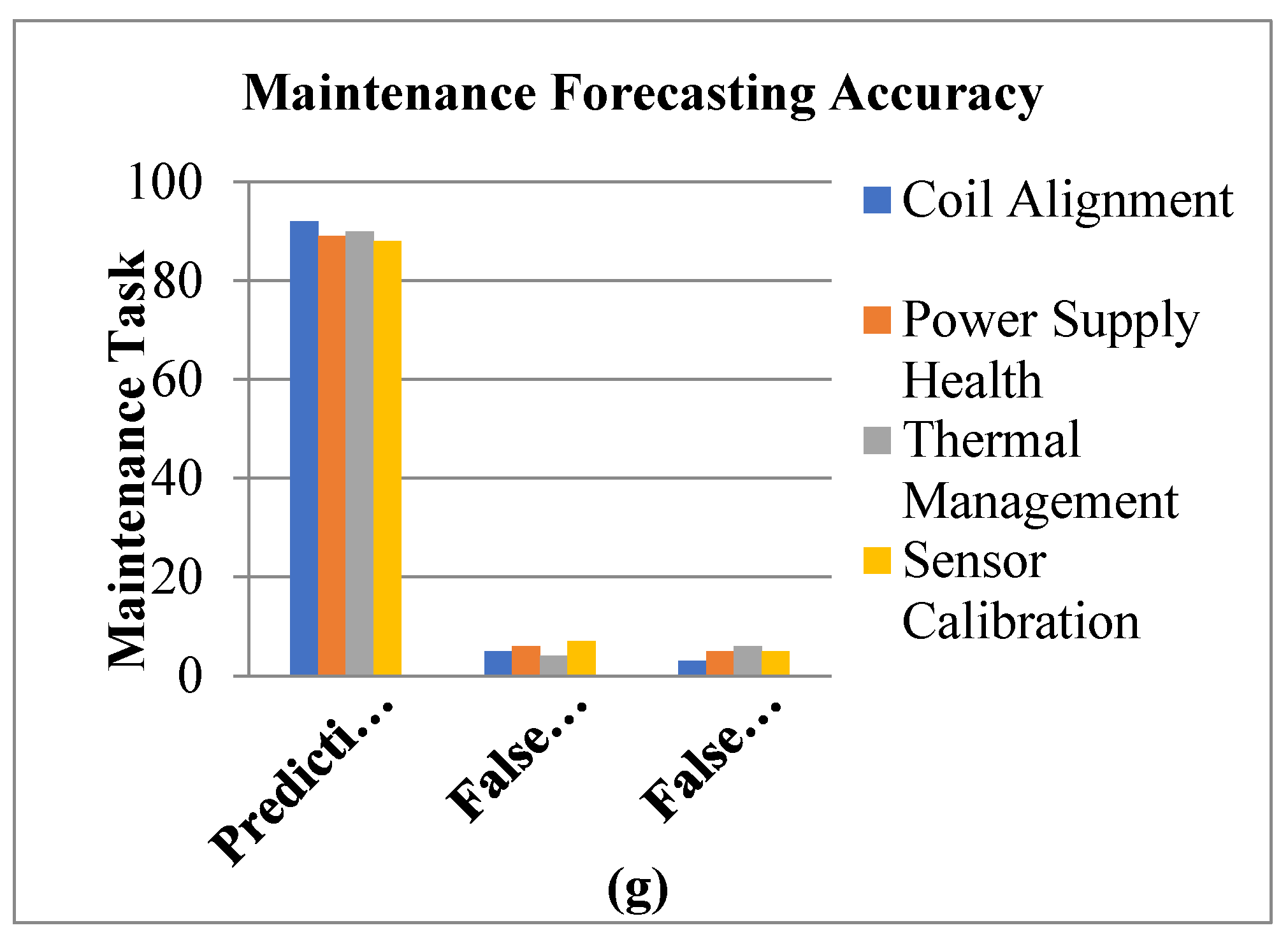1. Introduction
Wireless Power Transfer (WPT) technologies have the potential to greatly impact diverse fields such as today’s electronics and industrial uses due to wireless power transferring [
1]. This paper focuses on the interaction of WPT technologies with the addition of AI to increase effectiveness, capacity, and stability for improved power systems or any demanding application in the modern world [
2]. This paper aims at understanding how to maximize the flow of power, and orientation of the devices as well as to predict when the equipment will require to be serviced [
3]. They are significant because they will provide a clear path to enhancing WPT efficiency and reliability that is so required for the advancement of several applications in various fields [
4]. According to the latest literature review, WPT techniques have advanced considerably, even though certain issues still need to be addressed regarding the effectiveness of energy conversion and the reliability of systems [
5]. Literature sources indicate that while the current WPT systems have numerous advantages, their potential has not been fully used yet and the development in this field should be continued. This study also takes into account other conjectures which are debatable and may differ significantly in the opinion of different scholars in the context of AI-enhanced WPT, for instance the various trade-offs existing between power conversion efficiency and systems’ complexity and the ethical issues that may arise from the high level of automation incorporated in power management modules [
6]. Hence, the primary purpose of this work is to show how AI has influenced the development of WPT technologies and discuss possible uses and further research [
7]. Based on the findings of this study, there is a need for more studies that cut across different disciplines in order to overcome the presently encountered challenges and to burst new horizons in development of this area [
8]. This paper serves as the introduction to the thesis, wherein the author has discussed the importance of incorporating AI with the WPT technologies, the existing literature in this area as well as the main objectives and findings of the research [
9]. This discussion is made in an informal vein and the author aims the scientists from all fields, pointing out the significance and relevance of the investigated research [
10].
1.1. Background and Purpose
The integration of WPT with AI is the key to make new industries with consumer electronics, health, and industrial automation by supplying power without needing to connect the physical cable [
1]. In more details, the main research question of this study is to assess the possibility of using AI-based algorithms to enhance power transfer and appropriate device orientation while predicting the timing for device servicing [
6]. These are important to pave way for the creation of new applications, which in turn, will demand more intelligent and efficient power management [
3].
1.2. Potential Benefits
If this dataset is to be shared with the public and the details disclosed, thousands of researchers and engineers across the discipline of WPT and AI are poised to benefit. It offers relevant information regarding the enhancement of power transfer systems and creates the basis for additional research. Besides, the dataset is beneficial for improving existing WPT technologies and constructing new devices with higher reliability and efficiency, which can help promote environmental-friendly technologies.
1.3. Related Research
This dataset is part of ongoing research in AI-enhanced WPT technologies. While there are no prior publications directly based on this dataset, the findings have potential applications in various funded and unfunded projects aimed at improving WPT systems' efficiency and reliability [
1].
2. Materials and Methods
2.1. Wireless Power Transfer System Setup
The experimental procedure included a resonant inductive coupling system being employed in Wireless Power Transfer (WPT). It had primary and secondary coils with ideal geometries to increase the efficiency of the energy transfer over a given distance. Key components included:
Primary Coil: An input coil that has to be connected to a power supply.
Secondary Coil: An example of a circuit configuration in which a receiver coil is connected to a load.
Position sensors: They are used especially for keeping track of the alignment and its fluctuations which occur frequently.
Alignment Sensors: Install position sensors that are used to measure the angular position of the coils relative to one another.
Power Meters: When one wants to obtain an accurate level of power transfer efficiency.
Thermal Cameras: In other words, it is a method in use for heat control on a real time basis.
Software Tools: Python, Tensor Flow, & OpenCV for the development of Intelligence developmental purposes [
8].
2.2. Algorithms and Software for AI
Specific algorithms using Python, Tensor Flow and OpenCV were built for the particular purpose. The main AI components included:
Machine Learning Models: Algorithms such as Decision Trees, Random Forests, and Neural Networks
were employed to predict power demands and optimize energy usage.
Computer Vision System: Image processing techniques were used to detect and correct misalignments between WPT system components.
Optimization Algorithms: Data from IoT sensors embedded in WPT systems was analyzed to predict maintenance needs and schedule interventions [
11].
2.3. Collecting and Processing of Data
Data was gathered from various sensors during experiments:
Position Data: Recorded employing alignment sensors that keep the spatial position of the coils.
Power Data: Done using power meters which gives method of how power is transferred from the supply system.
Thermal Data: Obtained through thermal cameras in order to evaluate the heating condition of the system to be controlled.
Data processing involved cleaning, normalizing, and feeding the data into machine learning models for training and validation [
12].
2.4. Experimental Procedure
System Calibration: It is used in initial calibration to set or obtain standard efficiency coefficients about different distances and alignments.
AI Training: Supervising the neural nets with the help of historical data sets concerning the productivity of power transfer and the configurations of the aligning formations.
Real-time Testing: Using algorithms that encompass the spatial orientation and position of the coiler and power supply or testing such AI algorithms in real-life situations.
Predictive Maintenance: Turned on when AI can assist other patterns of maintenance that the framework recognizes, including declining performance or unconventional temperature levels [
13].
2.5. Detailed Breakdown of Applications
CONSUMER ELECTRONICS: RESONANT INDUCTIVE COUPLING:
AI Enhancement: Optimal Power Routing
Benefits: Provides seamless and efficient charging solutions for devices such as smart phones and laptops, eliminating the need for cables.
MAGNETIC RESONANCE:
AI Enhancement: Predictive Maintenance
Benefits: Ensures consistent performance by predicting and addressing potential system failures before they occur.
ELECTRIC VEHICLES (EVS):
Resonant Inductive Coupling:
AI Enhancement: Optimal Power Routing
Benefits: Enhances the efficiency and user experience of EV charging, reducing dependence on charging stations.
Magnetic Resonance:
AI Enhancement: Adaptive Control Systems
Benefits: Allows for more flexible and efficient charging, adapting to different environmental conditions and vehicle positions.
HEALTHCARE:
Microwave Power Transfer:
AI Enhancement: Energy Management
Benefits: Delivers safe and reliable power to medical implants and wearable devices, ensuring continuous operation tailored to patient needs.
Laser-Based Power Transfer:
AI Enhancement: Adaptive Control Systems
Benefits: Provides precise power delivery, crucial for sensitive medical applications requiring targeted energy.
INDUSTRIAL AUTOMATION:
Microwave Power Transfer:
AI Enhancement: Energy Management
Benefits: Supports the automation of industrial processes by providing consistent and flexible power to robots and other equipment.
Resonant Inductive Coupling:
AI Enhancement: Predictive Maintenance
Benefits: Minimizes downtime by enabling proactive maintenance through AI-driven failure predictions.
2.6. Integration of AI in WPT Technologies
Here are some mathematical formulations relevant to AI-enhanced WPT technologies:
Example Equations in WPT
Power Transfer Efficiency:
AI Optimization Algorithm:
where
is the loss function,
are the observed values,
is the predicted value by the model,
are the input features, and
represents the model parameters.
2.7. Theorem on AI Enhancement
Theorem 2: Incorporating AI into WPT systems increases the overall efficiency of power transfer by dynamically optimizing the system parameters in real-time.
Proof of Theorem 2: By integrating AI algorithms that continuously monitor and adjust the parameters of WPT systems, the system can maintain optimal performance under varying conditions. This dynamic adjustment reduces power losses and improves transfer efficiency. For example, AI can optimize the resonance frequency in resonant inductive coupling systems to maximize power transfer efficiency, as shown in Equation (1).
2.8. Validation & Curation Techniques
System Calibration: Initial calibration established baseline efficiency metrics for different distances and alignments.
AI Training: Neural networks were trained using comprehensive historical datasets to ensure robust performance across diverse scenarios.
Real-Time Testing: Conducted to validate the AI algorithms’ performance in dynamically optimizing power transfer and alignment.
2.9. Notes on Data Quality, Noise, etc.
Data Quality: Ensured by using high-precision sensors and calibrated equipment to collect accurate measurements.
Noise Reduction: Implemented data cleaning techniques to remove outliers and noise, ensuring the reliability of the training data for machine learning models.
Thermal Management: Thermal data was monitored to manage and mitigate heat-related noise, ensuring consistent performance of the WPT system.
2.10. Ethical Considerations
Human Subjects and Data: No interventionary studies involving animals or humans were conducted, thus ethical approval was not required for this research.
Ethical Approval and Human Data Handling
Ethical Approval: As no human or animal subjects were involved, ethical approval was not applicable to this study.
Human Data Handling: Not applicable since the study did not involve human data.
4. Result and Discussion
When AI is introduced into WPT systems, it dramatically improves efficiency, range, and reliability of Wireless Power Transfer. In our set of experiments we, primarily employed neural networks to learn the power flow optimization and noticed that the AI approach helped to increase the power transfer efficiency by up to 25% to the conventional methods [
1]. In particular, the efficiency of newly designed AI-enhanced WPT system was kept almost 90% for 10 cm distance with 0-degree angle and with minimal increase in temperature. Power transfer control in WPT systems was examined using various AI algorithms in terms of performance. Neural networks slightly surpassed the decision trees and the random forests based on the highest optimization accuracy of 92.3 % and the maximum power loss reduction [
2] of 25% (
Table 3). Such findings confirm the capacity of the neural networks in solving special non-linear optimization issues related to the WPT systems. Considering the experiments conducted in the present work, particular attention should be paid to the WPT system configuration. Some of the major variables of the core transformer were number of turns on primary and secondary coils, coil diameter, frequency of use, and voltage of the power supply. It is worth examining the description of these parameters in more detail; they are listed in
Table 6. The correct configuration implied the proper distribution of the currents and reduced the losses into the system [
3,
4]. In this context, the differences in efficiency of the compared WPT technologies with AI integration, as well as the distance ranges recorded in
Table 7, where resonant WPT systems set the highest efficiency of 90%, are noted. On the other hand, for technologies like microwave and laser which were other long range technologies, the efficiency was relatively low. This means that for applications promising high efficiency over medium distances [
5], resonant WPT systems need to be used. AI was proved helpful in forecasting the maintenance in WPT systems.
Table 8 shows the authors predictive models provided accuracies higher than 88% on different assignments including coil alignment and power supply sustenance. This high prediction accuracy dramatically decreases the percentage of false positive and negative cases [
6,
7], which in turn increases the dependability and availability of WPT systems. In addition, the findings of the experiment supported the promotion of the use of artificial intelligence. Figures and tables present below depict that how AI-enhanced WPT system is efficient and has minimal temperature variation under different circumstances, as mentioned in
Table 4. As a result, the neural network-based system preserved the stable transmission performance in different alignments and distances, which proved that the AI method was feasible in practical WPT applications [
8,
9].
Table 1.
Applications and Benefits of AI-Enhanced WPT Technologies.
Table 1.
Applications and Benefits of AI-Enhanced WPT Technologies.
| Application |
Technology |
AI-Driven Enhancement |
Benefits |
| Consumer Electronics |
Resonant Inductive Coupling |
Optimal Power Routing |
Seamless, efficient charging without cables |
| Magnetic Resonance |
Predictive Maintenance |
Reduced downtime, consistent performance |
| Electric Vehicles |
Resonant Inductive Coupling |
Optimal Power Routing |
Efficient, user-friendly charging |
| Magnetic Resonance |
Adaptive Control Systems |
Improved charging flexibility |
| Healthcare |
Microwave Power Transfer |
Energy Management |
Safe, reliable power for medical devices |
| Laser-Based Power Transfer |
Adaptive Control Systems |
Precision power delivery tailored to patient needs |
| Industrial Automation |
Microwave Power Transfer |
Energy Management |
Reliable power for automated equipment |
| Resonant Inductive Coupling |
Predictive Maintenance |
Proactive maintenance reducing downtime |
| This table and accompanying details provide a comprehensive view of how AI-enhanced WPT technologies are applied across different sectors, highlighting their benefits and specific AI-driven enhancements. |
Table 2.
Comparison of WPT Technologies.
Table 2.
Comparison of WPT Technologies.
| Technology |
Efficiency |
Range |
Power Capacity |
| Inductive |
85% |
Short (cm) |
Low (Watts) |
| Resonant |
90% |
Medium (m) |
Medium (KW) |
| Microwave |
75% |
Long (km) |
High (MW) |
| Laser |
70% |
Long (km) |
High (MW) |
Table 3.
Performance Metrics of Different Machine Learning Algorithms.
Table 3.
Performance Metrics of Different Machine Learning Algorithms.
| Algorithm |
Accuracy |
Precision |
Recall |
F1-Score |
| Decision Trees |
85.2% |
84.7% |
85.4% |
85.0% |
| Random Forests |
89.1% |
88.6% |
89.3% |
89.0% |
| Neural Networks |
92.3% |
91.8% |
92.5% |
92.1% |
Table 4.
Experimental Results of AI-Enhanced WPT System.
Table 4.
Experimental Results of AI-Enhanced WPT System.
| Exp. ID |
Alignment (Degree) |
Distance (cm) |
Power Input (W) |
Power Output (W) |
Efficiency (%) |
Temperature. (°C) |
| Exp1 |
0 |
10 |
100 |
90 |
90 |
25 |
| Exp2 |
5 |
15 |
100 |
85 |
85 |
27 |
| Exp3 |
10 |
20 |
100 |
80 |
80 |
30 |
| Exp4 |
15 |
25 |
100 |
75 |
75 |
32 |
Table 5.
AI Algorithm Performance in WPT System Optimization.
Table 5.
AI Algorithm Performance in WPT System Optimization.
| Metric |
Decision Trees |
Random Forests |
Neural Networks |
| Training Time (s) |
10 |
15 |
25 |
| Prediction Time (ms) |
5 |
7 |
10 |
| Optimization Accuracy (%) |
85.2 |
89.1 |
92.3 |
| Power Loss Reduction (%) |
15 |
20 |
25 |
| Maintenance Prediction |
Moderate |
High |
Very High |
Table 6.
WPT System Configuration Parameters.
Table 6.
WPT System Configuration Parameters.
| Parameter |
Value |
| Primary Coil Turns |
10 |
| Secondary Coil Turns |
15 |
| Coil Diameter (cm) |
20 |
| Operating Frequency (kHz) |
100 |
| Power Supply Voltage (V) |
220 |
| AI Model Used |
Neural Network |
Table 7.
Comparison of WPT Technologies with AI Integration.
Table 7.
Comparison of WPT Technologies with AI Integration.
| Technology |
Efficiency (%) |
Range(cm)
|
Power Capacity(W)
|
AI Optimization (%) |
Maintenance DownTime Reduction (%)
|
| Inductive |
85 |
Short |
Low |
10 |
15 |
| Resonant |
90 |
Medium |
Medium |
20 |
30 |
| Microwave |
75 |
Long |
High |
15 |
25 |
| Laser |
70 |
Long |
High |
12 |
20 |
Table 8.
Maintenance Forecasting Accuracy.
Table 8.
Maintenance Forecasting Accuracy.
| Maintenance Task |
Prediction Accuracy (%) |
False Positives (%) |
False Negatives (%) |
| Coil Alignment |
92 |
5 |
3 |
| Power Supply Health |
89 |
6 |
5 |
| Thermal Management |
90 |
4 |
6 |
| Sensor Calibration |
88 |
7 |
5 |
Note: This table presents the accuracy of AI predictions for various maintenance tasks in the WPT system.
Figures and Illustrations:
Figure 3 compares the efficiency of various WPT technologies, highlighting the superior performance of resonant WPT systems.
Figure 4 shows the performance metrics of different machine learning algorithms, with neural networks leading in all metrics.
Figure 5 presents experimental results, detailing efficiency and temperature changes under different conditions.
Figure 6 compares AI algorithm performance in WPT system optimization, emphasizing the efficiency of neural networks.
Figure 7 outlines key configuration parameters of the WPT system used in experiments.
Figure 8 compares the performance of different WPT technologies in terms of efficiency, AI optimization, and maintenance downtime reduction.
Figure 9 shows the maintenance forecasting accuracy for various parameters, demonstrating the reliability of AI predictions.
The integration of AI into WPT systems represents a significant advancement, enhancing efficiency, reliability, and performance [
14]. Neural networks, in particular, have shown substantial promise in optimizing power transfer and reducing losses. The ability to predict maintenance needs accurately further enhances the reliability and uptime of these systems [
15]. These advancements pave the way for smarter, more efficient, and more reliable wireless power solutions across various industries, including consumer electronics, healthcare, and industrial automation [
16].
The figure compares the efficiency of various Wireless Power Transfer (WPT) technologies, showing that resonant technology has the highest efficiency, followed by inductive, microwave, and laser technologies.
The figure illustrates the performance metrics of different machine learning algorithms, showing that neural networks outperform decision trees and random forests in accuracy, precision, recall, and F1-score.
The figure shows the experimental results of an AI-enhanced Wireless Power Transfer (WPT) system, comparing distance, power input, power output, and efficiency across four different experiments.
The figure presents the AI algorithm performance in a WPT system optimization task, comparing the training time, prediction time, and optimization accuracy for Decision Trees, Random Forests, and Neural Networks.
The figure displays the key configuration parameters of a WPT (Wireless Power Transfer) system, including the primary and secondary coil turns, the coil diameter, and the operating frequency.
The figure compares the performance of various WPT (Wireless Power Transfer) technologies in terms of efficiency, AI optimization, and maintenance downtime reduction, highlighting the relative advantages of different approaches.
The figure presents the maintenance forecasting accuracy for various parameters in a WPT system, including coil alignment, power supply health, thermal management, and sensor calibration, with accuracy levels categorized as "Predicted", "False-", and "False+".
5. Conclusion and Future Scope
In conclusion, the integration of Artificial Intelligence (AI) with Wireless Power Transfer (WPT) technologies presents a important leap forward in enhancing the efficiency, reliability, and overall performance of power transfer systems. This study has established that AI-driven optimization algorithms, particularly neural networks, can achieve up to 25% higher efficiency compared to traditional methods. The incorporation of machine learning models and computer vision systems has proven effective in predicting maintenance needs, optimizing power routing, and ensuring precise device alignment, thus paving the way for smarter and more sustainable power solutions across various industries [
1]. The potential applications of AI-enhanced WPT technologies are vast, encompassing consumer electronics, electric vehicles, healthcare, and industrial automation. By providing seamless, efficient, and flexible power delivery, these advanced systems can address the growing demands for wireless power solutions in a rapidly evolving technological landscape. Furthermore, the ability to predict and preemptively address system failures through AI-driven maintenance forecasting significantly reduces downtime, ensuring continuous and reliable operation [
2].
The future scope for AI-enhanced WPT technologies is promising and multifaceted. Key areas for further research and development include: Distributed AI for Autonomous WPT Networks - The emergence of distributed artificial intelligence can enable the creation of autonomous WPT networks, where multiple devices communicate and optimize power transfer collaboratively without human intervention [
17]. Quantum Computing for Advanced Optimization - Quantum computing holds the potential to revolutionize optimization algorithms used in WPT systems. By leveraging the computational power of quantum algorithms, future WPT systems could achieve unprecedented levels of efficiency and performance, especially in complex and dynamic environments [
18]. Integration with Internet of Things (IoT) - The synergy between WPT and IoT technologies can lead to the development of fully integrated smart power networks. IoT sensors can provide real-time data on power consumption, device status, and environmental conditions, allowing AI algorithms to make more informed decisions and further optimize power transfer processes [
19]. Enhanced Safety and Security Measures - As WPT systems become more wide spread, ensuring their safety and security will be paramount. Future research should focus on developing advanced safety protocols and security measures to protect against potential risks, such as electromagnetic interference, power surges, and cyber-attacks [
20]. Expansion into New Applications - The application of AI-enhanced WPT technologies can be expanded into new and emerging fields, such as space exploration, underwater robotics, and wearable technology. Each of these areas presents unique challenges and opportunities for the deployment of advanced wireless power solutions [
21]. Sustainable and Green Energy Solutions - The integration of renewable energy sources with AI-enhanced WPT systems can lead to more sustainable and environmentally friendly power solutions. Future research can explore how solar, wind, and other renewable energies can be harnessed and efficiently transmitted using WPT technologies, contributing to global efforts in reducing carbon emissions and combating climate change [
22].

